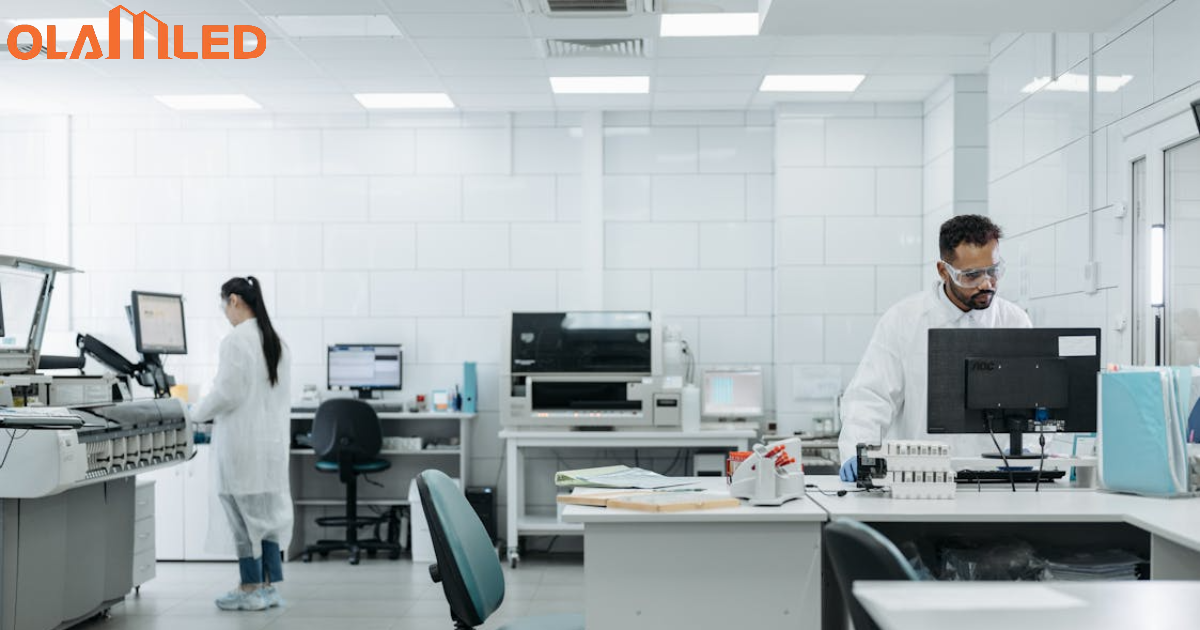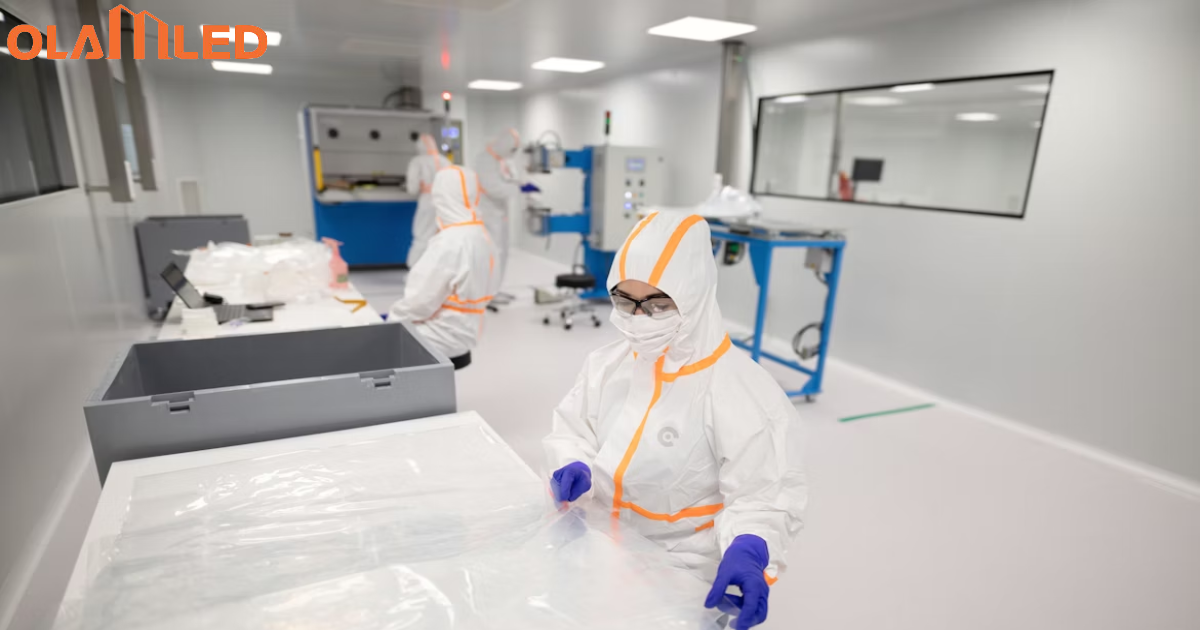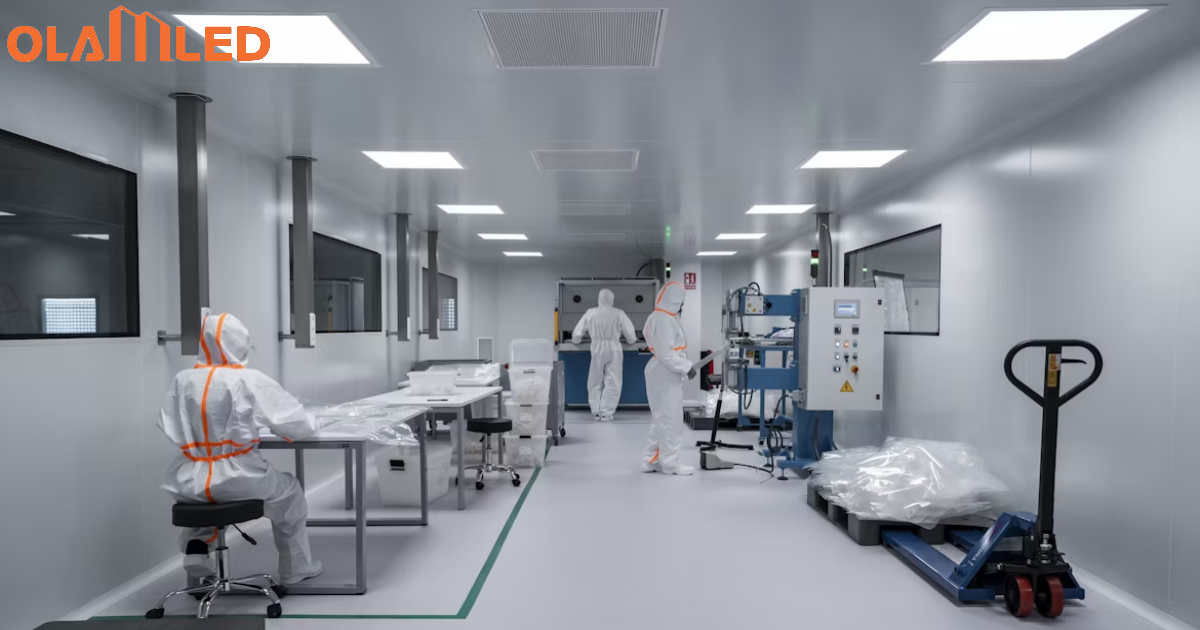Operating a successful factory is no easy task. Ensuring that you have the necessary resources and technology to produce quality products efficiently can be challenging, but it’s essential in order for your business to remain competitive.
One of those essentials is ensuring that your factory features appropriate lighting. Not only is effective lighting necessary for safety and productivity in the workplace, but it can also save you money in energy costs if implemented correctly.
Quality LED industrial-grade lights from companies like Olamled are now providing businesses with safe, energy-efficient lighting solutions that meet their various needs and budgets. The key to correctly illuminate a LED manufacturing facility lies in the selection of superior lighting. We will be exploring this topic and why decision-making must take place with due consideration given.
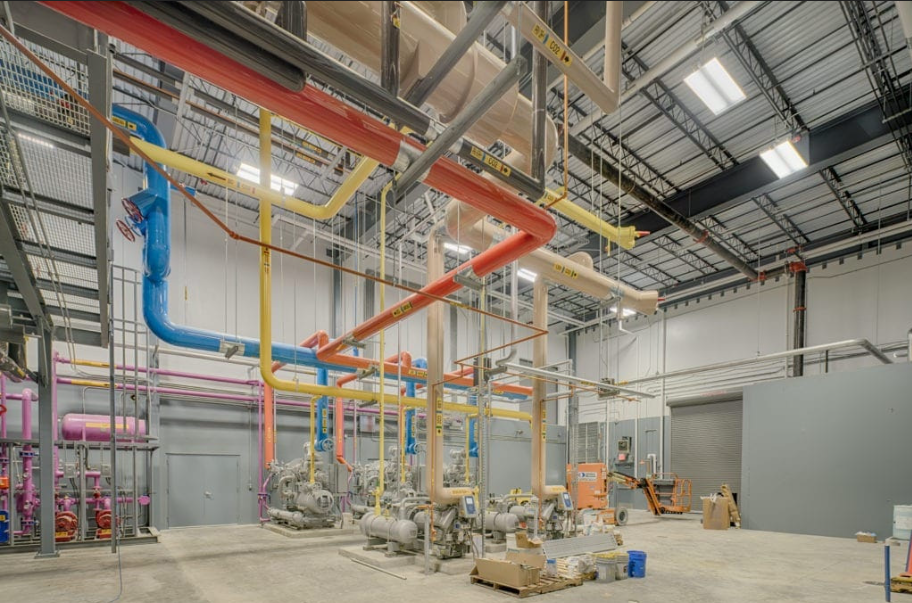
Types Of Industrial Lighting!
Selection of the right kind of illumination for a factory scenario can be mystifying without having any idea about lighting mechanisms. Here is an overview on some widely used industrial fitting options:
1. Incandescent Lighting:
Most households and businesses utilize conventional light bulbs, which create an inviting atmosphere; yet unfortunately they can be quite inefficient since the majority of energy is converted to heat. With regular use of incandescent lamps you could end up with a high-energy bill. They also do not last as long compared to other lighting solutions, though they can still be acquired at an inexpensive price.
Your factory setting might require a more appropriate type of lighting since these aren’t suitable for industrial applications. However, they can be used as supplementary lighting.
2. Fluorescent Lighting:
Fluorescent lights may be a suitable option for factories since they provide good illumination at an affordable cost and are energy efficient compared to incandescent bulbs.
That said, fluorescent tubes tend to flicker and require more maintenance as they’re prone to frequent repairs. The other downside is that their color rendering index, which measures a light source’s ability to accurately render colors, falls short of LED lights in the market.
Along with that, these bulbs take time to warm up and reach full brightness.
3. LED Lighting:
Acting as a more economic choice when it comes to long-term energy consumption and illumination, LED lighting supplies considerable savings plus options for personalization. This type of industrial lighting is specifically designed for factory applications, providing commercial and residential establishments with brighter illumination than fluorescent or incandescent lights along with having a higher CRI score (color rendition index).
Furthermore, LED fixtures don’t require frequent repairs like fluorescent or incandescent lights since the LEDs themselves have a lifespan of up to 50,000 hours. You also need to follow the industrial lighting design guide.
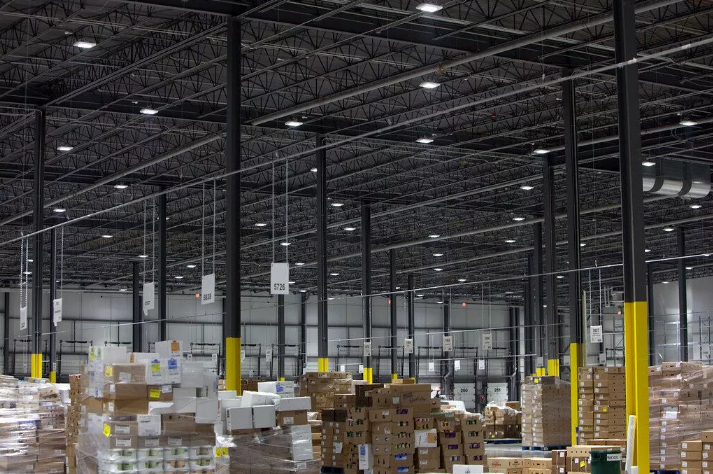
Why LED Is The Best Lighting For The Manufacturing Environment?
Industrial manufacturing necessitates careful assessment of safety and productivity in relation to illumination.
LED lights are a superb choice for those seeking an upgrade due to the number of advantages they bring – from boosting energy efficiency over other lighting sources, plus improved formulae for employee safety and productivity. Let’s take a look at why the use of LEDs makes perfect sense in an industrial setting.
1. Lower Energy Costs:
LEDs are much more efficient than other light sources, and this makes them the most affordable solution in terms of consumption over long periods of time as they typically require 80-90% less electricity compared to traditional lights.
You can drastically reduce your energy costs by choosing LED factory lighting over other sources like incandescent and fluorescent. Comparing a 60w LED to an equivalent 180 W incandescent bulb, the energy savings could be as high as 90%.
2. Longer Life Span:
LEDs last longer than regular lights and don’t need frequent replacements like fluorescent or incandescent lights. LEDs boast a long life span of up to 50,000 hours compared with only around 8500 for regular bulbs.
Making this type of light the more reliable choice in factory lighting is an obvious requirement due to the various rough operating conditions that usually exist in factory settings.
While it may cost more upfront to purchase, you’ll save money in the long-run as there won’t be any need for frequent replacements or repairs.
3. Safer Environment:
LEDs don’t use toxic materials like mercury like fluorescent lights do, which can be potentially harmful if it leaks out. LED lighting also doesn’t produce ultraviolet or infrared radiation in the visible light spectrum as many other types of bulbs do.
Therefore providing a safer atmosphere for your employees and protecting any sensitive materials you may be manufacturing in your factory.
Different situations may require different types of LED lighting for a factory, but it’s essential to consider the safety aspect when making your decision.
4. Improved Brightness:
LED luminaires can produce brighter light as opposed to other sources and can offer a better quality of illumination for increased safety on the job. The higher lumens output for LED lighting allows your staff to see more clearly, even in dark areas where regular lights wouldn’t provide enough brightness.
In many cases, LEDs are brighter and consume less energy than traditional bulbs in the same wattage range. Some LED fixtures also come with the option to adjust their contrast and brightness levels, making better use of each space within a factory.
So, if you’re looking for efficient illumination that provides reliable brightness in even the darkest of spaces, installation and using LED fixtures would be a wise decision.
5. Better Color Rendering:
Another benefit of LED lights is the better color rendition they provide. LEDs offer a higher Color Rendering Index (CRI) than regular bulbs, which indicates how accurately colors are seen under certain lighting conditions.
High CRI LEDs produce a more natural and vibrant light that is essential for certain factory applications such as those found in the leather tanning industry.
This can make identifying various quality issues with your products much easier, thus improving efficiency along production lines. Like other LEDs, they last longer and use far less energy than their traditional counterparts.
6. Reduced Maintenance:
The failure rate of LED lighting is much lower than other types, thus requiring very little to no repairs owing to their sturdiness. LEDs also have a significantly longer life span compared with regular bulbs which means you don’t have to constantly worry about replacements.
With regular lights, you would normally incur extra costs in terms of labor and energy usage required for changing out the bulbs or tube fittings frequently during repair work which is obviously not the case with LED lighting solutions.
7. Ability To Switch Between Colors:
Depending on the type of factory setting, you may require different types of lighting at particular times or areas within it – be that a cool white light for monitoring and inspection purposes in certain areas, or a warm white light for other sections.
LED lighting is extremely adjustable and can switch between different colors easily with the push of a button which makes them suitable when you need to customize your application based on factory lighting requirements.
8. Instantaneous Switch-On:
LEDs take very little time to fully turn on thus offering you an instant illumination source for your factory space whenever required as opposed to other lighting sources that require a certain “warm up” period before reaching full brightness.
This makes LEDs highly suitable for situations where an instantaneous light is required, such as safety other emergency response operations in factories.
9. Shock Resistance:
LEDs are more resistant than regular bulbs when exposed to sudden shocks or vibrations which can be a common occurrence in factory settings.
Regulation of light vibration is crucial for ensuring your workers stay aware and alert while they’re on the job, as any unexpected shifting may cause accidents to occur.
Switching over to LED lighting can help you improve safety levels and eliminate any accidents due to vibrations or shocks.
10. Eco-Friendly:
Unlike regular bulbs, LEDs don’t contain harmful chemicals which make them an ideal choice for projects where the maintenance of the environment is essential.
Also, these lamps don’t produce any harmful radiation so you don’t have to worry about potential risks from that aspect either. So if your factory requires eco-friendly lighting solutions then LEDs are an ideal option for you.
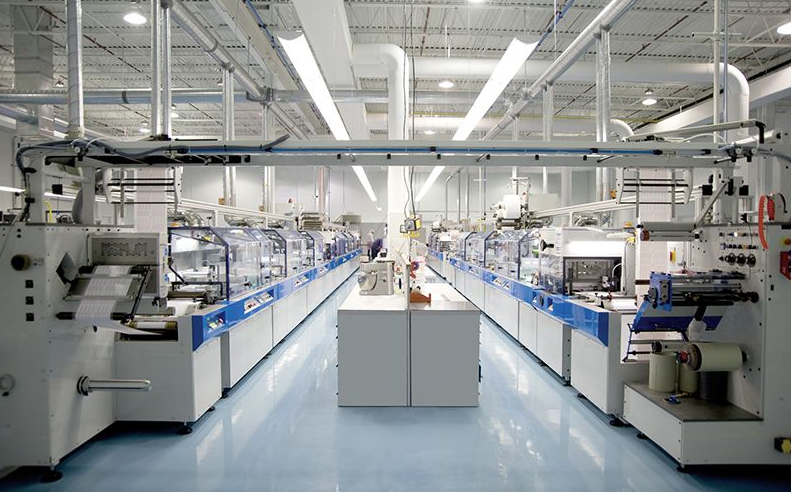
Choosing The Right Type Of LED Lighting For Your Factory!
Now that you have an understanding of why and how LEDs are beneficial in factory settings, it’s essential to determine which type would be best-suited for your establishment before making a purchase. Here are some key factors to consider when choosing the right LED lighting products or solutions:
1. The Type Of Work Being Done In Each Area:
Depending on what is going on within these spaces, factory owners must select accordingly. For instance, metal-working spaces or manufacturing areas may require higher lumen outputs for safety due to the increased level of activity and potential heat generated from machines within these environments.
On the other hand in offices, reception areas or other safe locations, a low lumen output may be sufficient since the level of activity and potential safety concerns are lower. Therefore choosing LED lighting with appropriate lumens rating is essential in each situation.
2. Space Layout:
Considering the size and shape of each area is important because it will determine which type and how many LED lights you need to install. This can also help decide whether or not a dimming feature would be beneficial since brighter spaces may require adjustable brightness levels in different areas.
If your factory has a lot of off-limits spaces, then low bay fixtures may be ideal as they provide directional illumination. Also, they conserve energy and don’t need to reach higher ceiling heights like high bay lighting does in larger factories or warehouses.
3. The Total Wattage:
The wattage of a lighting system can be examined to decide how effective it is and if less luminous lamps are enough. Examining the amount of watts used may help reduce total consumption.
4. Light Color Temperature:
Light color temperature is measured in Kelvin which indicates a light’s warmth or coolness and can vary depending on the type of work being done within each area.
Cooler light temperatures tend to be better suitable for inspection activities while warmer ones allow workers to ease up and focus on their work without strain or fatigue which is vital in long shifts within the workplace
5. Power Factor:
The power factor indicates how much of the energy used by the light is actually being transformed into visible brightness.
High efficiency LEDs tend to have a higher PF rating, thus meaning they produce more lumens per watt and consume less electricity than low Efficiency alternatives with lower PF ratings.
6. CRI:
As mentioned previously, it’s important to ensure that you select an LED light with a higher color rendition index (CRI) if you require accurate colors for particular applications.
Choosing a higher CRI rating will ensure that the color of objects in your factory look natural and vibrant under LED lighting as opposed to saturated or dull hues produced by regular bulbs with lower CRIs.
7. Lumen Maintenance:
Lumen Maintenance is a measure of how the LED light will perform and stay bright over time. This can indicate whether you need multiple replacement bulbs or some type of preventive maintenance done in order to preserve optimal lighting output at all times in your establishment.
8. Emergency Lighting:
Factories and warehouses may require reliable emergency back-up systems during power outages or other unforeseen occurrences; therefore selecting night lights, motion sensors or even fully integrated dial lighting control systems may be a wise decision in such cases.
9. Operating Temperatures:
LEDs used for industrial settings must tolerate extreme hot and cold temperature variances which is important to consider as it affects the lifespan of each LED light.
Some locations within the organization may require cooling systems to reduce heat dissipation, or areas with higher natural temperatures should probably consider replacing their LEDs more frequently than other cooler settings in order to prolong efficiency levels of each fixture
10. Mounting Choices:
Different LED lights are mounted in different ways and you need to ensure that each one is securely attached with the appropriate fittings for your type of mounting option (such as a ceiling or wall). You should also consider how easy it would be to access each light for repairs and replacements in case of any faults.
11. Expected Lifetime Costs:
It may cost more upfront to install LED lighting compared with regular bulbs, but the longer lifespan results in fewer replacements over time which saves you money in the long run. So when making a decision it’s important to consider expected lifetime costs rather than just upfront expenses as LED lighting pays for itself eventually
12. Warranty:
LEDs come with a variety of warranties that guarantee their performance over time when maintained correctly, including lumen maintenance and other related issues.
Different lighting products may come with different warranty periods so you should be sure to read the fine print before spending your hard earned money on a particular type of product.
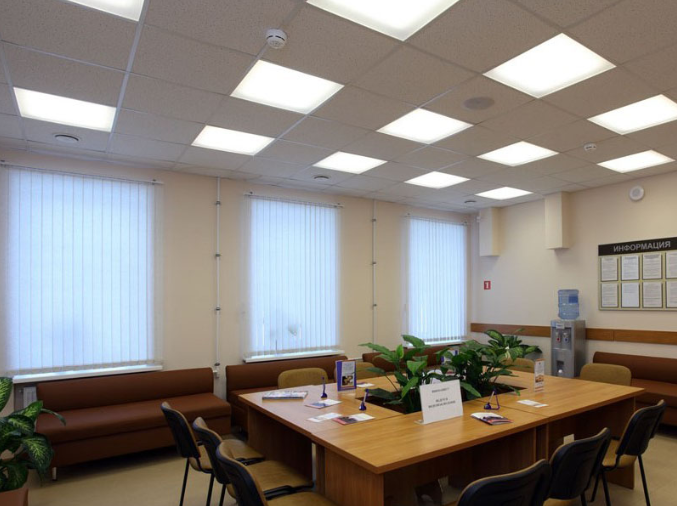
Conclusion:
Quality lighting for your LED factory is a priority, as the appropriate blaze can offer highest efficiency in production, safety and electricity utilization both right away and over time.
Before putting money into any solution be aware of all relevant factors associated with what you need in your industrial environment. To get the most in return, it is essential that you go for premium real materials for illumination.
Rely on these points to ease your mind when selecting lighting for industrial purposes.
Visit the Olamled website to explore even more options and find the perfect balance of energy savings, high Brightness levels, durability and reliability for any factory or warehouse application.
